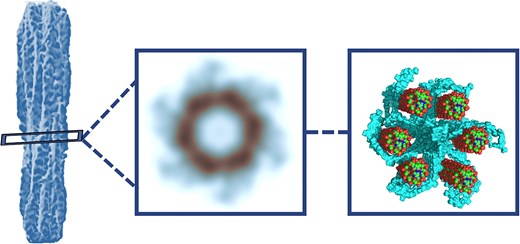In all organisms, DNA is folded to fit inside the cell, because the length of DNA in a chromosome is much longer than the length of a cell. This folding is done by specific proteins in the cell. For bacteria, nucleoid-assisted proteins bridge DNA strands to compact them whereas in more complex cells with nuclei, the role is carried out by proteins called histones.
In this study, published in Nucleic Acids Research, the researchers focused on the bacterial protein E. coli Hfq (Host factor Q-beta). Hfq is best known for its role in RNA-related processes, but it can also act as a DNA-bridging protein, linking two distant regions of DNA.
It uses an amyloid-like region in its structure for the bridging, which is different to the coiled-coil structure of the more common histone-like nucleoid structuring proteins found in more complex organisms. The structure of the Hfq C-terminal region, which is responsible for DNA bridging, is not well characterised and therefore its mechanism is not fully understood.
To investigate the bridging mechanism in Hfq in more detail, an international research team from France, Spain, Japan, Denmark, Singapore and ISIS used a range of characterisation techniques, including neutron methods.
They used cryo-electron microscopy alongside atomic force microscopy and small angle and inelastic neutron scattering (SANS / INS) measurements. By using contrast variation, their SANS experiment at the ILL enabled them to highlight one component in the system at a time, while suppressing the contribution of the other component of the complex.

Above: graphical abstract showing the process of structural determination of the C-terminal extension of Hfq.
Their INS experiments on Tosca at ISIS allowed them to follow the dynamical response of the hydrated complex. INS allowed them to directly investigate the conformational changes of the protein because the motions involved in the process are in the right frequency range measured by the technique.
When combined, their results from all these techniques enabled the team to propose a model for the complex formed by the amyloid portion of Hfq and DNA.
“We identified a unique mechanism in which the nucleoid-associated protein Hfq binds DNA edge-on and oligomerises into amyloid filaments, rather than wrapping DNA around its surface like in eukaryotic nucleosomes," says Véronique Arluison from Laboratoire Léon Brillouin, the paper's corresponding author.
This novel mechanism of DNA bridging is important for genome organisation and the regulation of gene expression in simple cells and is also likely to be important for more complex cells. It will also shed light on the possible expanding role of amyloids, which are implicated in neurodegenerative diseases.
The full paper can be found at DOI:10.1093/nar/gkaf169
